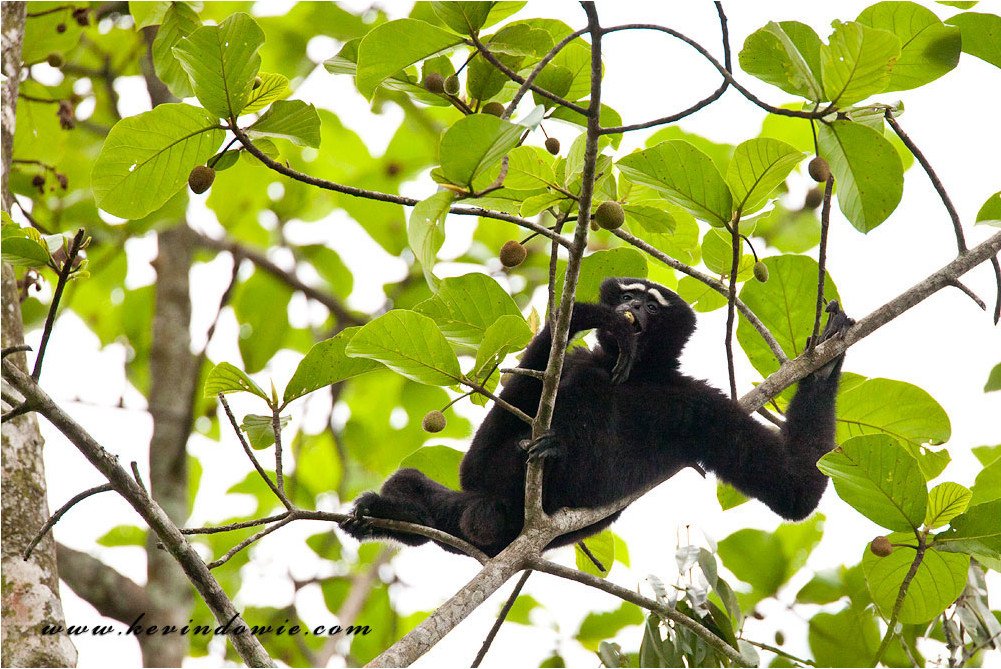In a small wildlife reserve in Assam, India, a troop of endangered hoolock gibbons lives in the treetops. In this post, we go in search of wild gibbons.

During my travels through Assam, India in 2010, I visited a small wildlife reserve where a troop of hoolock gibbons was known to live in the treetops. After a bit of searching, we sighted about 6 or 8 gibbons as they swung through the foliage high above the ground.
Photographing wild Gibbons
Photographing them was a real challenge. Firstly, the adult males are almost entirely black in colour (the females are brown) and because I was shooting from ground level, they were strongly back-lit, so enormous contrast range. Secondly because of the dense foliage, just getting a clear, unobstructed, view was tough. Given the distance between me and the gibbons, I was using long lenses as well, the 500mm f4 mounted on a tripod which I was frequently moving so as to frame the shots, and a 70-300mm zoom handheld and used at the 300mm end of its range.
In addition to sighting wild gibbons, I visited a small zoo in the area and there was able to get some sound recording. The recording you hear in this presentation is of a lone captive gibbon calling out. The wild gibbons that I observed were fairly quiet, I gather that they are at their most vocal early morning. The captive specimen was calling and screeching during the middle of the day and was quite agitated in its enclosure. Being a primate, it’s highly intelligent and social and I couldn’t help but think that alone in captivity it was severely stressed. Sad.
*** Note: When playing the slideshow, don’t be tempted to turn the sound volume up. The volume starts out soft, but soon gets plenty loud! ***
Above: Western Hoolock Gibbon, Assam Province, India. Click for the audio-visual presentation.
A few gibbon facts.
It’s now accepted that there are two separate species of hoolock gibbons, the western hoolocks (seen here) and the eastern hoolocks. There is very little size difference between the males and females both reaching about 6 to 9 kg in weight. Hoolocks are found in Assam in North-East India, Myanmar (Burma), and in small numbers in eastern Bangladesh and southwest China. They live in monogamous pairs, which stake out a territory and use their calls to locate family members and deter other gibbons from their territory. Their diet consists of insects, leaves, flowers, and fruits including figs which they can be seen eating in the slideshow. The gibbons perform an important function in a forest by distributing seeds through their foraging.
Hoolocks are born after a seven-month gestation, take 8 to 9 years to fully mature, and have a life expectancy of about 25 years in the wild.
Conservation Issues.
There are numerous threats to Western hoolock gibbons in the wild, and they are now entirely dependent on human action for their survival. The western hoolock gibbon is considered an endangered species with its numbers falling by about 90% since the early 1970s. At that time numbers were estimated at more than 100,000 with around 80,000 in Assam alone. It’s believed that today there are less than 5,000 left.
Prime habitat for gibbons is broad-leaved, wet evergreen, and semi-evergreen forests, where there is a contiguous canopy. Habitat loss is critical with forest clearance for agriculture, notably tea cultivation, and the practice of slash-and-burn cultivation. Although legally protected, they continue to be hunted for food, “medicine” and capture for trade.
Blogging Issues.
Apologies for the slow start to the blogging year, the second half of January before I’ve put up any content! A few work issues to sort out, I won’t bore anyone with the details but hopefully, I can be a little more blog productive over the next month or so. ~ KD
